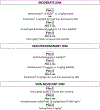Updates on Juvenile Dermatomyositis from the Last Decade: Classification to Outcomes
- PMID: 34635298
- PMCID: PMC9725116
- DOI: 10.1016/j.rdc.2021.07.003
Updates on Juvenile Dermatomyositis from the Last Decade: Classification to Outcomes
Abstract
Juvenile dermatomyositis (JDM) is a heterogeneous disease with new classification criteria and updates in myositis-specific autoantibody and myositis-associated antibody groups. There are many validated assessment tools for assessing disease activity in JDM. Future studies will optimize these tools and improve feasibility in clinical and research contexts. Genetic and environmental risk factors, mechanisms of muscle pathology, role of interferon, vascular markers, and changes in immune cells provide insights to JDM pathogenesis. Outcomes have improved, but chronic disease, damage, and mortality highlight the need for better outcome predictors and treatments. Increased collaboration of stakeholders may help overcome research barriers and improve JDM treatment.
Keywords: Biologic therapies; Juvenile dermatomyositis (JDM); Juvenile myositis (JM); Myositis-specific autoantibodies (MSA); Outcomes; Pathogenesis; Treatment.
Published by Elsevier Inc.
Figures


References
-
- Bohan A, Peter JB. Polymyositis and dermatomyositis (second of two parts). N Engl J Med 1975;292(8):403–7. - PubMed
Publication types
MeSH terms
Substances
Grants and funding
LinkOut - more resources
Full Text Sources
Medical

